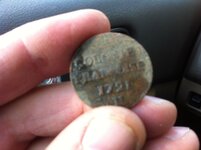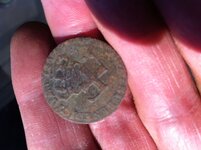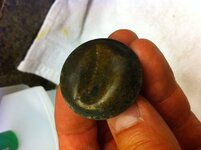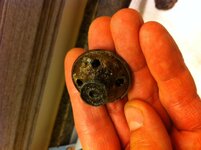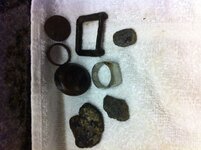bergie
Bronze Member
- Aug 2, 2004
- 1,815
- 1,147
Research really paid off today. I drove to Charleston from north Florida for some detecting and check some Civil War sites. There were two lesser known forts and I found a map that described their location. While I wasn't at the exact site, most importantly I found a section of what looked like original land about 60 yards long and 10 yards wide directly along the river just west of Charleston. I knew people would have been there. Today the land is just an unpaved strip at the end of a hotel parking lot. However, I figured in all these years somebody must have detected it. But, I got a small buckle pretty quickly and that was very encouraging. Then I got a nice hit and - "bang" - out of the ground comes this terrific 1721 9 Denier...H marked (The B is quite rare, but H isn't bad either). Very cool to find my oldest coin ever. Also found a modern steel ring, an old (maybe) copper ring (or it's just a copper fitting; it has patena but hard to tell). Also, does anyone know about the old knob looking thing with holes in bottom? Looks brass or copper. Here's more about the Diener - Does anyone know approx value?:
The first large-scale emission of copper coins for the American continent was not struck in London, or New Haven, or Morristown, or Philadelphia. It wasn’t struck in 1749, or 1787, or 1793. It was struck in 1721, in the French cities of La Rochelle and Rouen.
By the edict of June 1721, an emission of about 5 million copper coins denominated as 9-denier pieces were authorized by the French crown for all French colonies of the New World, including Canada; French-controlled areas of the interior of North America; the young city of New Orleans and the province of Louisiana; and the French islands of the Caribbean.
The coins bear a simple design: the obverse shows the large legend COLONIES FRANCOISES or “the colonies of the French,” along with the date and Mint mark, B for Rouen or H for La Rochelle. On the reverse, two large crowned crossed L’s (for Louis XV) appear along with the legend SIT NOMEN DOMINI BENEDICTUM or “Blessed be the name of the Lord.”
Just a small proportion of those authorized were struck, though exact mintages are unknown.
About 534,000 were sent to Canada in 1722, but, in a situation reminiscent of what happened with the Virginia halfpence of 1773, they sat in a warehouse until local authorities got permission to circulate them.
Compared to English halfpence and French sous, they were dramatically underweight. Undeterred, authorities revalued them at 6 deniers, but they still weren’t widely accepted. In 1726, most of them were shipped back to France, rejected and unused.
Strong evidence suggest the coins saw wider circulation in Louisiana, and some or most of the rejected pieces from Canada seem to have ended up there. They have been found archaeologically in places like Louisiana and coastal Alabama, proving their presence in the area, despite the fact that early 18th century sites there typically yield few coins.
The average grade of surviving 1721 and 1722 9-denier pieces today averages around Very Good, and surface problems are commonplace. With just three years of active circulation in Canada before their rejection and shipment back to France, presumably most of the extensive circulation they saw – decades upon decades judging from the typical very worn survivors – took place in French Louisiana. Why most American collectors dismiss them as Canadian is confounding, particularly considering the popularity of so many issues with little or no provable American connection.
Any 1721 or 1722 9-denier coin is scarce, and the 1721-B 9-denier pieces coined at Rouen stand as one of the significant rarities of the early American copper series.
The first large-scale emission of copper coins for the American continent was not struck in London, or New Haven, or Morristown, or Philadelphia. It wasn’t struck in 1749, or 1787, or 1793. It was struck in 1721, in the French cities of La Rochelle and Rouen.
By the edict of June 1721, an emission of about 5 million copper coins denominated as 9-denier pieces were authorized by the French crown for all French colonies of the New World, including Canada; French-controlled areas of the interior of North America; the young city of New Orleans and the province of Louisiana; and the French islands of the Caribbean.
The coins bear a simple design: the obverse shows the large legend COLONIES FRANCOISES or “the colonies of the French,” along with the date and Mint mark, B for Rouen or H for La Rochelle. On the reverse, two large crowned crossed L’s (for Louis XV) appear along with the legend SIT NOMEN DOMINI BENEDICTUM or “Blessed be the name of the Lord.”
Just a small proportion of those authorized were struck, though exact mintages are unknown.
About 534,000 were sent to Canada in 1722, but, in a situation reminiscent of what happened with the Virginia halfpence of 1773, they sat in a warehouse until local authorities got permission to circulate them.
Compared to English halfpence and French sous, they were dramatically underweight. Undeterred, authorities revalued them at 6 deniers, but they still weren’t widely accepted. In 1726, most of them were shipped back to France, rejected and unused.
Strong evidence suggest the coins saw wider circulation in Louisiana, and some or most of the rejected pieces from Canada seem to have ended up there. They have been found archaeologically in places like Louisiana and coastal Alabama, proving their presence in the area, despite the fact that early 18th century sites there typically yield few coins.
The average grade of surviving 1721 and 1722 9-denier pieces today averages around Very Good, and surface problems are commonplace. With just three years of active circulation in Canada before their rejection and shipment back to France, presumably most of the extensive circulation they saw – decades upon decades judging from the typical very worn survivors – took place in French Louisiana. Why most American collectors dismiss them as Canadian is confounding, particularly considering the popularity of so many issues with little or no provable American connection.
Any 1721 or 1722 9-denier coin is scarce, and the 1721-B 9-denier pieces coined at Rouen stand as one of the significant rarities of the early American copper series.
Attachments
Last edited:
Upvote
23


